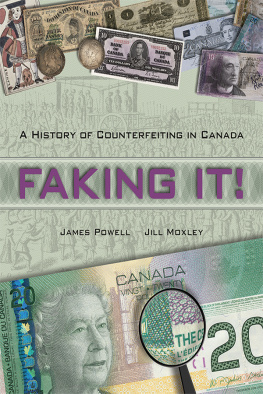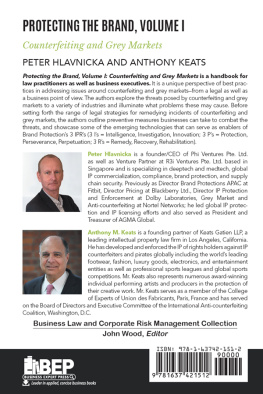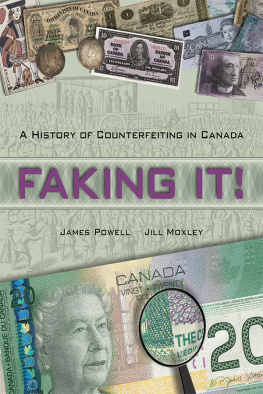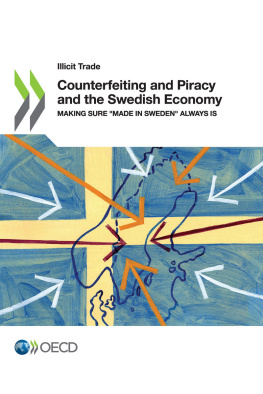FAKING IT!
A H ISTORY OF C OUNTERFEITING IN C ANADA

FAKING IT!
A H ISTORY OF C OUNTERFEITING IN C ANADA

JAMES POWELL AND JILL MOXLEY


GENERAL STORE PUBLISHING HOUSE INC.
499 OBrien Road, Renfrew, Ontario, Canada K7V 3Z3
Telephone 1.613.432.7697 or 1.800.465.6072
http://www.gsph.com
ISBN 978-1-77123-044-5
77123-784-0 (EPUB)
77123-098-8 (MOBI)
77123-099-5 (PDF)
Copyright James Powell, Jill Moxley 2013
Design: Magdalene Carson
Published in Canada
No part of this book may be reproduced, stored in a retrieval system, or transmitted in any form or by any means without the prior written permission of the publisher or, in case of photocopying or other reprographic copying, a licence from Access Copyright (Canadian Copyright Licensing Agency), 1 Yonge Street, Suite 1900, Toronto, Ontario, M5E 1E5.
Cataloguing data available at Library and Archives Canada
To all the talented and dedicated men and women
whose innovations and art keep our money safe
TABLE OF CONTENTS
ACKNOWLEDGEMENTS
We could not have written this book without the help of many friends and former colleagues at the Bank of Canada. Particular thanks go to Gerry Gaetz, former chief of the Currency Department, and his staff, especially Michael Duncan, Sophie Jenkins, Nicole Poirier, Charles Spencer, and Marie Terrien. Thanks also go to Jill Vardy, chief of the Communications Department; Paul Berry and David Bergeron, respectively chief curator and curator of the National Currency Collection; Jane Boyko, the Banks archivist; Gordon Carter and Glyn Davies, the Banks photographers; Pierre Duguay, retired Deputy Governor; and Bonnie Schwab, retired adviser to the governor and former head of the Central Bank Counterfeit Deterrence Group (CBCDG). Their comments and suggestions were immensely helpful. The Banks archives were an invaluable treasure trove of material, while the Banks National Currency Collection was the source of most of the illustrations that enrich the text. We would also like to acknowledge with thanks the financial contribution made by the Bank of Canada, which allowed the many illustrations to be produced in colour.
We would additionally like to express our gratitude to the Royal Canadian Mounted Police (RCMP), especially Sergeant Sue MacLean, National Counterfeit co-ordinator, and Superintendent Stephen Foster. The RCMP was the source of valuable information regarding recent counterfeiting activity, including statistics and pictures of counterfeiting seizures. RCMP staff also read and commented on an earlier draft of the manuscript.
We also gratefully acknowledge the help of Heather Darch, curator of the Missisquoi Museum located in Stanbridge East, Quebec, who provided us with images and information concerning the nineteenth-century counterfeiters in Quebecs Eastern Townships.
Thanks also to Patricia Buchanan, who prepared the index, and to our editor, John Stevens, who helped whip our book into shape for publication. We also want to thank proofreader Nancy Syrett, and all the other members of the great team at the General Store Publishing House, headed by Tim Gordon, who took a chance on us.
Finally, we would like to thank our spouses, Robert Moxley and Nicolle Powell, who provided us with valuable advice, encouragement, and emotional support. Nicolle also helped in preparing illustrations for publication. Our sons, Andrew Powell and Matthew Moxley, provided effective technical support.
The views expressed in this book, as well as all errors and oversights, are those of the authors and are not attributable to any other person, the Bank of Canada, or the RCMP.
The authors have received permission from the Bank of Canada to reproduce, in whole or in part, images of Canadian bank notes pursuant to the Banks policy on the reproduction of bank-note images.
PREFACE
Why are we fascinated by tales of counterfeiting? Is it the fantasy of having our own personal money tree in the backyard? Or are we intrigued by a crime whose cunning perpetrators try to beat the system? Every day, we all use various kinds of metal discs and pieces of paper or plastic, trusting that they are genuine and that they are worth the value displayed. The craftsmanship and technical wizardry employed to ensure that these expectations are met are cutting edge. Thus, the criminals who try to replicate these objects for their own profit are usually not the common-or-garden variety. Counterfeiting calls for ingenuity and talent, and it touches something we all tend to take for grantedthe money in our pockets. And it can personally affect any one of us when we least expect it. During our fast-paced day, how often do we slow down to check the change we receive at shops, restaurants, or even the local corner store?
While the focus of this book is on counterfeiting in Canada, it has a wider reach. We begin with some history of the crimea crime as old as money itself. We look at its sometimes gruesome punishments and at the reasons why counterfeiting is not a victimless crime. We also explore the techniques employed to fight it through the centuries, discuss the arms race between the issuers of money and the relentless counterfeiters, and delve into cases of official counterfeiting.
Turning to the Canadian experience, we examine the development of banking in North America and the concomitant rise of the counterfeiters who were quick to take advantage of the introduction of paper currency. We also highlight some of the riveting counterfeiting cases of the past and their colourful characters, both the criminals themselves and their police adversaries. Moving into modern times, we examine the activities of the Bank of Canada and the Royal Canadian Mounted Police (RCMP), who are on the front line in the battle to maintain confidence in the currency. Major counterfeiting busts by the RCMP are highlighted. Since forgers dont respect national frontiers, we also look at international efforts to fight counterfeiting. Finally, we consider frauds involving credit and debit cards and electronic payment systemsthe new Wild West of financial crime.
We hope that the reader will not only enjoy this account but will also gain an appreciation for the serious nature of the crime and a better understanding of the constant struggle waged by the issuers of payment instruments to protect the money in our pockets.
1
T HE S ECOND -O LDEST P ROFESSION
Fraud has been called the second-oldest profession. While the assertion is hard to substantiate, there is little doubt that swindles have been part of life since humankind first engaged in economic transactions. According to ancient Greek mythology, the Titan Prometheus divided a sacrificed animal into two parts: one for the gods and one for humans. In the first pile, he hid the valuable meat under a heap of offal. In the second, he wrapped the bones and skin in rich-looking fat. Asked to choose between the two offerings, Zeus, king of the gods, took the second pile. Having defrauded the gods, Prometheus earned the enmity of Zeus and the gratitude of humanity.













